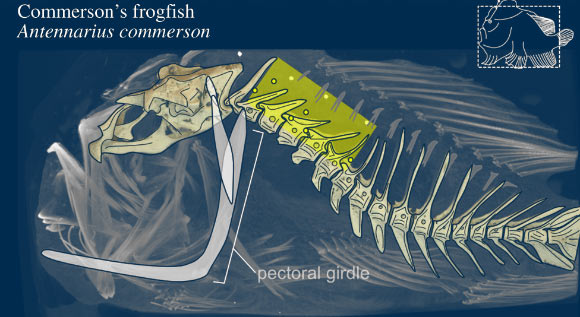
Trout and frogfish can bend their spines and heads upwards, despite having different anatomy from humans and other land-dwelling vertebrates, according to a study by University of Liverpool’s Dr. Ariel Camp.
Craniovertebral skeleton of the Commerson’s frogfish (Antennarius commerson). Image credit: Ariel L. Camp, doi: 10.1098/rspb.2021.1091.
Dr. Camp used X-ray reconstruction of moving morphology to measure 3D vertebral kinematics in the rainbow trout (Oncorhynchus mykiss) and the Commerson’s frogfish (Antennarius commerson) during feeding.
“Instead of using just the vertebral joints right behind the head like a human would, these fish flexed up to two-thirds of their spine when lifting their heads to eat,” Dr. Camp said.
“This shows fish move their spine three-dimensionally during swimming and feeding, helping us understand the evolution of the backbone — and specifically the neck — in vertebrate animals.”
“Tetrapods use their neck to move the head three-dimensionally, relative to the body and limbs.”
“Fish lack this anatomical neck, yet during feeding many species elevate the head relative to the body.”
“Cranial elevation is thought to result from the craniovertebral and cranialmost intervertebral joints acting as a neck, by dorsally rotating (extending).”
“However, this has never been tested due to the difficulty of visualizing and measuring vertebral motion in vivo.”
Craniovertebral skeleton of the rainbow trout (Oncorhynchus mykiss). Image credit: Ariel L. Camp, doi: 10.1098/rspb.2021.1091.
Despite different morphologies, in rainbow trout and Commerson’s frogfish dorsoventral rotations extended far beyond the craniovertebral and cranial intervertebral joints.
Trout combine small (most less than 3°) dorsal rotations over up to a third of their intervertebral joints to elevate the neurocranium.
Frogfish use extremely large (often 20-30°) rotations of the craniovertebral and first intervertebral joint, but smaller rotations occurred across two-thirds of the vertebral column during cranial elevation.
Unlike tetrapods, fish rotate large regions of the vertebral column to rotate the head.
“This suggests both cranial and more caudal vertebrae should be considered to understand how non-tetrapods control motion at the head-body interface,” Dr. Camp said.
The study was published in the Proceedings of the Royal Society B: Biological Sciences.
_____
Ariel L. Camp. 2021. A neck-like vertebral motion in fish. Proc. R. Soc. B 288 (1957): 20211091; doi: 10.1098/rspb.2021.1091
 #Bizwhiznetwork.com Innovation ΛI |Technology News
#Bizwhiznetwork.com Innovation ΛI |Technology News



